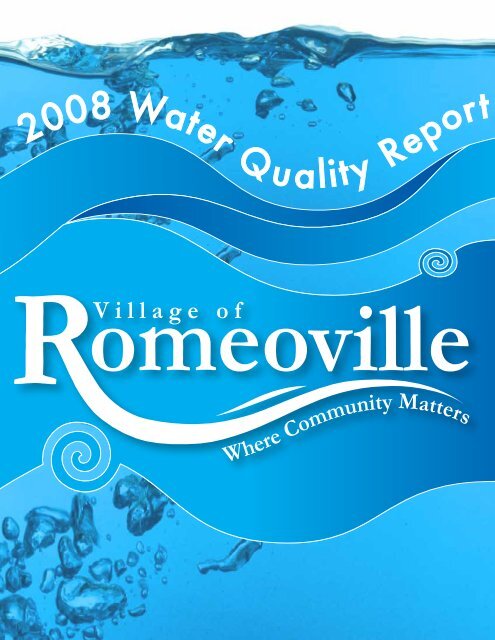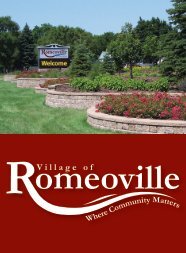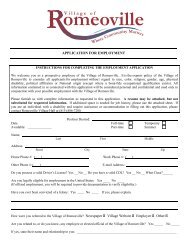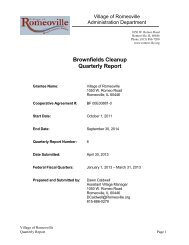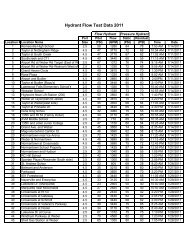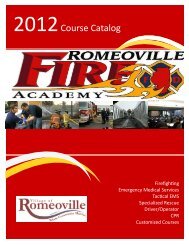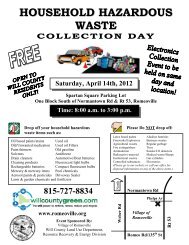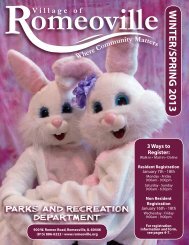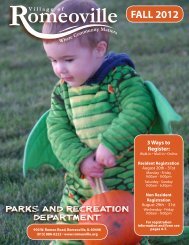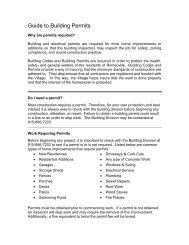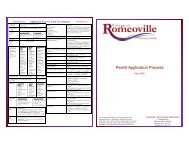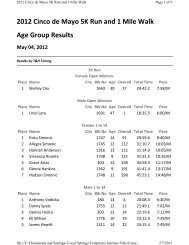2008 Water Quality Report - Village of Romeoville
2008 Water Quality Report - Village of Romeoville
2008 Water Quality Report - Village of Romeoville
You also want an ePaper? Increase the reach of your titles
YUMPU automatically turns print PDFs into web optimized ePapers that Google loves.
<strong>Water</strong> <strong>Quality</strong> <strong>Report</strong><br />
The Safe Drinking <strong>Water</strong> Act (SDWA), promulgated by Congress in 1974, amended in 1986 and 1996, establishes a<br />
Federal program to monitor and increase the safety <strong>of</strong> the nation’s drinking water supply. The SDWA authorizes the U.S.<br />
Environmental Protection Agency (EPA) to set and implement health based standards to protect against both naturally<br />
occurring and man-made contaminants in the drinking water. The EPA is also responsible for assessing and protecting<br />
drinking water sources; protecting wells and collection systems; making sure water is treated by qualified operators;<br />
ensuring the integrity <strong>of</strong> distribution systems; and making information available to the public on the quality <strong>of</strong> their<br />
drinking water.<br />
This report provides information regarding the quality <strong>of</strong> the drinking water delivered to you by the <strong>Village</strong> <strong>of</strong> <strong>Romeoville</strong><br />
in <strong>2008</strong>. Included are details about where your water comes from, what it contains and how it compares to standards<br />
set by regulatory agencies.<br />
Where does your water come from?<br />
The kitchen sink, that’s easy! It <strong>of</strong>ten feels that simple, but the water supply provided by the <strong>Village</strong> has somewhat <strong>of</strong> a more<br />
complicated route before you actually use it in your homes or businesses.<br />
The <strong>Village</strong> <strong>of</strong> <strong>Romeoville</strong> draws its groundwater supply from 5 deep wells (pumping water from 1,000 ft. below the surface)<br />
and 7 shallow wells (pumping from 80 ft. below the surface) located throughout the <strong>Village</strong>. We provide water to the<br />
residents <strong>of</strong> the <strong>Village</strong> <strong>of</strong> <strong>Romeoville</strong> and portions <strong>of</strong> unincorporated Plainfield and Bolingbrook.<br />
Once the raw water is pumped, chlorine is added for disinfection. This treated water is then transported to various storage<br />
tanks throughout the <strong>Village</strong>. Through a maze <strong>of</strong> mains, the water is then pumped to all areas <strong>of</strong> the <strong>Village</strong>. Feeding <strong>of</strong>f the<br />
main line is each individual service line leading into your residence or business. A curb stop is installed at the beginning <strong>of</strong><br />
the service line just <strong>of</strong>f the main which serves as the primary access to terminate and restore water service. As the service<br />
line feeds into the home, there is a shut-<strong>of</strong>f valve just prior to the water meter. This valve is owned and maintained by the<br />
resident and allows them to terminate the supply <strong>of</strong> water feeding into the home when needed.<br />
Did you know<br />
The <strong>Village</strong> <strong>of</strong> <strong>Romeoville</strong> monitors the tank levels, pressures, and flow through a centralized computer<br />
system called SCADA (Supervisory Control and Data Acquistion) used for gathering and analyzing real<br />
time data. Levels in the storage tanks do not remain constant throughout the day. During the night<br />
and early morning hours, the tank levels are at their highest. As the usage throughout town increases,<br />
the tank levels decrease. This cycle allows constant pumping rates and minimizes the number <strong>of</strong><br />
starts and stops on the pumping equipment.<br />
The <strong>Village</strong> <strong>of</strong> <strong>Romeoville</strong> is continuing to install water meters with remote registers called<br />
Orion that can be read with a device that does not require an employee the need to gain<br />
access to your residence (phone service is no longer required for this device). If you are<br />
interested in scheduling an appointment to have the Orion meter installed in your home or<br />
you would like more information relating to this device please call (815) 886-7200.<br />
Did<br />
you know...<br />
<strong>Water</strong> is the only<br />
substance found on<br />
earth in three forms<br />
solid, liquid, and gas.
Each <strong>of</strong> the following ion exchange facilities are tested for radium throughout the year to ensure compliance. Radium levels<br />
in all <strong>of</strong> the <strong>Village</strong> <strong>of</strong> <strong>Romeoville</strong>’s facilities are currently below the Federal Environmental Protection Agencies standard <strong>of</strong><br />
5pCi/L. Five ion exchange plants have been constructed at this time, these facilities are necessary to prevent elevated levels<br />
<strong>of</strong> radium from re-occurring at the deep well sites. In addition to reducing the radium in the water, the ion exchange plants<br />
also improve the aesthetics <strong>of</strong> the water (s<strong>of</strong>tening).<br />
IX Facility (Airport Road) has been in service since July 1, 2005. Radium levels have ranged from 2.5-3.0pCi/l since the<br />
operation <strong>of</strong> the new Ion exchange filters. This facility had the highest level <strong>of</strong> combined Radium 9.4pCi/l in 2003. The<br />
hardness has also been improved. The current level ranges from 222-257mg/l or 13- 15 grains <strong>of</strong> hardness. Previous hardness<br />
levels reported were 376-428mg/l or 22-25 grains <strong>of</strong> hardness.<br />
IX Facility (Fairfax) has been in service since March 1, 2006. Radium levels have ranged from 2.5-3.0pCi/l since the operation<br />
<strong>of</strong> the new Ion exchange filters. This facility is one <strong>of</strong> our largest suppliers <strong>of</strong> water with the highest level <strong>of</strong> combined Radium<br />
being 7.7pCi/l in 2004. The hardness has also been improved with the new plant. The current level ranges from 324-393mg/l<br />
or 19-23 grains <strong>of</strong> hardness. Previous hardness levels reported were 547-735mg/l or 32-43 grains <strong>of</strong> hardness.<br />
IX Facility (Carillon) has been in service since July 1, 2006. Radium levels have ranged from 1.2-3.0pCi/l since the operation<br />
<strong>of</strong> the new Ion exchange filters. The highest<br />
recorded level <strong>of</strong> combined radium for this<br />
facility was recorded in 2004 at 8.4pCi/l. The<br />
hardness has also been improved with the<br />
new plant. The current level ranges from<br />
205-239 mg/l or 12-14grains <strong>of</strong> hardness.<br />
Previous hardness levels reported were 376-<br />
428mg/l or 22-25 grains <strong>of</strong> hardness.<br />
Service Area 1<br />
IX Facility (Normantown) has been in<br />
service since November 1, 2007. Radium Service Area 2<br />
levels have ranged from 1.1-1.4pCi/l since Service Area 3<br />
the operation <strong>of</strong> the new Ion exchange<br />
filters. The highest recorded level <strong>of</strong><br />
combined radium for this facility was<br />
recorded in 2004 at 6.1pCi/l. The hardness<br />
has also been improved with the new plant.<br />
The current level ranges from 324-376<br />
mg/l or 19-22grains <strong>of</strong> hardness. Previous<br />
hardness levels reported were 513-547mg/l<br />
or 30-32 grains <strong>of</strong> hardness.<br />
IX Facility (Windham Lakes) has been<br />
in service since May 1, 2009. The current<br />
radium level is 1.7 pCi/l since the operation<br />
<strong>of</strong> the new Ion exchange filters. The highest<br />
level <strong>of</strong> combined Radium for this facility<br />
was recorded in 2003 at 9.4pCi/l. The<br />
hardness has also been improved with the<br />
new plant. The current level ranges from<br />
273.6-290mg/l or 16-17 grains <strong>of</strong> hardness.<br />
Previous hardness levels reported were 461-<br />
513mg/l or 27-30 grains <strong>of</strong> hardness.<br />
Ion Exchange Plants
What is Ion Exchange S<strong>of</strong>tening<br />
Ion Exchange S<strong>of</strong>tening is a BATT (Best Available Treatment Technology), which is a common approach to removing a variety<br />
<strong>of</strong> dissolved solids in water. It exchanges both cations (positively charged particles) and anions (negatively charged particles)<br />
depending on the application. For hardness and radium removal, a cationic exchange process is used. The process involves<br />
a pressurized vessel filled with coated synthetic material. The material is heavily loaded with sodium ions, but because<br />
the coating on the material has a higher affinity for other cations, the sodium is exchanged with calcium, magnesium and<br />
radium ions as they come in contact with the media. As the process continues, all available sodium ions are exchanged<br />
and the media will require regeneration. To accomplish this, a sodium chloride solution saturates the media. The saturation<br />
overrides the media’s affinity for the other cations and re-coats the surface with sodium ions for the next treatment cycle.<br />
The remaining solution is flushed from the vessels into a waste system. The regeneration process results in a 3 to<br />
5 percent waste, which is favorable when compared to other radium treatment technologies, such as Reverse<br />
Osmosis treatment (up to 25% waste).<br />
The removal percentage <strong>of</strong> hardness and radium using ion exchange is 98% to 100%. However, treating all<br />
<strong>of</strong> the water supply with ion exchange s<strong>of</strong>tening can lead to aggressive water. To polish the water, experts<br />
recommend that operators bypass and blend a percentage <strong>of</strong> the water. In <strong>Romeoville</strong>, bypassing<br />
occurs in differing amounts depending on the radium, hardness levels in the raw water and the desired<br />
removal amount.<br />
The Ion Exchange S<strong>of</strong>tening process produces high-quality water. The reduction <strong>of</strong> hardness<br />
reduces scale and lime build-up on fixtures and increases the life <strong>of</strong> water heaters and dishwashers.<br />
It results in slightly higher operation and maintenance costs due to the use <strong>of</strong> a brine solution for<br />
the regeneration process but municipalities would probably agree that the benefits <strong>of</strong> s<strong>of</strong>t water,<br />
free <strong>of</strong> contaminants outweighs the slightly higher costs associated with the treatment process.<br />
Drinking water, including bottled water, may reasonably<br />
be expected to contain at least small amounts <strong>of</strong> some<br />
contaminants. The presence <strong>of</strong> contaminants does not<br />
necessarily indicate that water poses a health risk. More<br />
information about contaminants and potential health<br />
effects can be obtained by calling the USEPA’s Safe Drinking<br />
<strong>Water</strong> Hotline at (800) 426-4791. In order to ensure that<br />
tap water is safe to drink, EPA prescribes regulations<br />
which limit the amount <strong>of</strong> certain contaminants in water<br />
provided by public water systems. FDA regulations<br />
establish limits for contaminants in bottled water which<br />
must provide the same protection for public health.<br />
Some people may be more vulnerable to contaminants<br />
in drinking water than the general population.<br />
Immuno-compromised people with cancer undergoing<br />
chemotherapy, those who have undergone organ<br />
transplants, people with HIV/AIDS or other immune<br />
<strong>Water</strong> <strong>Quality</strong><br />
Did<br />
you know...<br />
In a five minute<br />
shower 25 to 50<br />
gallons <strong>of</strong> water<br />
are used.<br />
The <strong>Village</strong> <strong>of</strong> <strong>Romeoville</strong> tests over 1,300 water samples a year, for more than 120 different substances<br />
including microbial organisms, inorganic compounds, (including lead and copper), organic compounds<br />
(including pesticides and herbicides) and radioactive material. Our licensed staff, along with state and<br />
federal regulators, routinely monitor our operations, compliance, and testing protocols to ensure that we deliver<br />
safe, high quality drinking water to our customers.<br />
system disorders, some elderly and infants can be<br />
particularly at risk from infections. These people should<br />
seek advice about drinking water from their health care<br />
providers. USEPA/CDC guidelines on appropriate means<br />
to lessen the risk <strong>of</strong> infection by Cryptosporidium and<br />
other microbial contaminants are available from the<br />
USEPA’s Safe Drinking <strong>Water</strong> Hotline 800-426-4791.<br />
The sources <strong>of</strong> drinking water (both tap water and<br />
bottled water) include rivers, lakes, streams, ponds,<br />
reservoirs, springs, and groundwater wells. As water<br />
travels over the surface <strong>of</strong> the land or through the<br />
ground, it dissolves naturally-occurring minerals<br />
and, in some cases, radioactive material, and can<br />
pickup substances resulting from the presence <strong>of</strong><br />
animals or from human activity.
Source <strong>Water</strong><br />
Possible contaminants consist <strong>of</strong>:<br />
• Microbial contaminants, such as viruses and bacteria, which may come from sewage treatment plants, septic systems,<br />
agricultural livestock operations and wildlife:<br />
• Inorganic contaminants, such as salts and metals, which may be naturally occurring or result from urban storm water<br />
run<strong>of</strong>f, industrial or domestic wastewater discharges, oil and gas production, mining or farming;<br />
• Pesticides and herbicides, <strong>of</strong> which may come from a variety <strong>of</strong> sources such as agriculture, urban storm water run<strong>of</strong>f and<br />
residential uses;<br />
• Organic chemical contaminants, including synthetic and volatile organic chemicals, which are by-products <strong>of</strong> industrial<br />
processes and petroleum production, and can also come from gas stations, urban storm water run<strong>of</strong>f and septic systems;<br />
and<br />
• Radioactive contaminants, which may be naturally occurring or be the result <strong>of</strong> oil and gas production and mining activities.<br />
Source <strong>Water</strong> Assessment<br />
Based on information obtained in a Well Site Survey published by the Illinois EPA, eight potential sources or possible<br />
problem sites were identified within the survey area <strong>of</strong> <strong>Romeoville</strong>’s wells. Furthermore, information provided by the Leaking<br />
Underground Storage Tank and Remedial Project Management Sections <strong>of</strong> the Illinois EPA indicated several additional sites<br />
with ongoing remediations that may be <strong>of</strong> concern. The Illinois EPA has determined that the source water obtained from<br />
<strong>Romeoville</strong>’s Wells #4, #7, #9, #10, #11, and #13 is not susceptible to contamination. However, the source water obtained from<br />
Wells 1, #3, #5, #8, and #12 is susceptible to contamination. This determination is based on a number <strong>of</strong> criteria including;<br />
monitoring conducted at the wells; monitoring conducted at the entry point to the distribution system; and the available<br />
hydrogeologic data on the wells.<br />
To view a summary version <strong>of</strong> the completed Source <strong>Water</strong> Assessments, including: Importance <strong>of</strong> Source <strong>Water</strong>; Susceptibility<br />
to Contamination Determination; and documentation/recommendation <strong>of</strong> Source <strong>Water</strong> Protection Efforts, you may access the<br />
Illinois EPA website at http://www.epa.state.il.us/cgi-bin/wp/swap-fact-sheets.pl.<br />
<strong>Water</strong> <strong>Quality</strong> Table Definitions:<br />
Active Level (AL): The concentration <strong>of</strong> contaminants that, if exceeded, trigger treatment or other required actions by the water supply<br />
Action Level Goal (ALG): The level <strong>of</strong> a contaminant in drinking water below which there is no known or expected risk to health. ALG’s allow for a<br />
margin <strong>of</strong> safety<br />
Maximum Contaminant Level (MCL): The highest level <strong>of</strong> a contaminant that is allowed in drinking water. MCL’s are set as close to the Maximum<br />
Contaminant Level Goal as feasible using the best available treatment technology<br />
Maximum Contaminant Level Goal (MCLG): The level <strong>of</strong> a contaminant in drinking water below which there is no known or expected risk to<br />
health. MCLG’s allow for a margin <strong>of</strong> safety.mg/l: milligrams per litre or parts per million - or one ounce in 7,350 gallons <strong>of</strong> water.ug/l: micrograms<br />
per litre or parts per billion - or one ounce in 7,350,000 gallons <strong>of</strong> water<br />
N/A: Not applicable<br />
Avg: Regulatory compliance with some MCLs are based on running annual average <strong>of</strong> monthly samples<br />
Maximum Residual Disinfectant Level (MRDL): The highest level <strong>of</strong> disinfectant allowed in drinking water<br />
Maximum Residual Disinfectant Level Goal (MRDLG):The level <strong>of</strong> disinfectant in drinking water below which there is no known or expected risk<br />
to health. MRDLG’s allow for a margin <strong>of</strong> safety<br />
Parts Per Billion (ppb): One part per billion (or micrograms per liter)<br />
Parts Per Million (ppm): One part per million (or milligrams per liter)
<strong>Water</strong> <strong>Quality</strong> Test Results<br />
<strong>2008</strong> Regulated Contaminants Detected<br />
The following tables contain scientific terms and measures, some <strong>of</strong> which may require explanation. In addition to the following contaminants<br />
that were detected in the water supply, over 100 contaminants were tested for and were NOT DETECTED in the water supply<br />
LEAD & COPPEER<br />
If present, elevated levels <strong>of</strong> lead can cause serious health problems, especially for pregnant women and young children. Lead in drinking water is primarily<br />
from materials and components associated with service lines and home plumbing. The <strong>Village</strong> <strong>of</strong> <strong>Romeoville</strong> is responsible for providing high quality<br />
drinking water, but we cannot control the variety <strong>of</strong> materials used in plumbing components. When your water has been sitting for several hours, you can<br />
minimize the potential for lead exposure by flushing your tap for 30 seconds to 2 minutes before using water for drinking or cooking. If you are concerned<br />
about lead in your water, you may wish to have your water tested. Information on lead in drinking water, testing methods, and steps you can take to<br />
minimize exposure is available from the Safe Drinking <strong>Water</strong> Hotline or at http://www.epa.gov/safewater/lead.<br />
Results <strong>of</strong> Monitoring for Lead & Copper<br />
Results meet or surpass state and federal drinking water regulations.<br />
Collection<br />
Date<br />
Lead<br />
MCLG<br />
Lead Action<br />
Level (AL)<br />
Lead 90th<br />
Percentile<br />
Number <strong>of</strong><br />
Sites over<br />
Copper<br />
MCLG<br />
Copper<br />
Action<br />
Level (AL)<br />
Copper<br />
90th<br />
Percentile<br />
Number <strong>of</strong><br />
Sites Over<br />
Copper AL<br />
Likely Source <strong>of</strong><br />
Contamination<br />
Violation<br />
<strong>2008</strong> 0 15 ppb
INORGANIC CHEMICALS<br />
Inorganic chemicals (IOCs) include salts, metals, minerals and nutrients which can be naturally occurring or which can result from storm<br />
water run<strong>of</strong>f, wastewater discharges, or farm activities. Because our source <strong>of</strong> drinking water is groundwater, a significant amount <strong>of</strong> naturally<br />
occurring minerals are dissolved in the water.<br />
Results <strong>of</strong> Monitoring for Inorganic Chemicals<br />
Results meet or surpass state and federal drinking water regulations<br />
Inorganic<br />
Contaminants<br />
Collection<br />
Date<br />
Highest Level<br />
Detected<br />
Range <strong>of</strong> Levels<br />
Detected<br />
MCLG MCL Units Violation Likely Source Of Contaminant<br />
Fluoride Monthly 1.85 1.00 - 1.85 4 4 ppm No<br />
Barium <strong>2008</strong> 0.115 .033 - .115 2 2 ppm No<br />
Nitrate (measured<br />
as Nitrogen)<br />
<strong>2008</strong> 1.913 0 - 1.913 10 10 ppm No<br />
Erosion <strong>of</strong> natural deposits; <strong>Water</strong> additive which<br />
promotes strong teeth; Fertilizer discharge<br />
Discharge <strong>of</strong> drilling wastes; Discharge from metal<br />
refineries; Erosion <strong>of</strong> natural deposits<br />
Run<strong>of</strong>f from fertilizer use; Leaching from septic<br />
tanks, sewage; Erosion <strong>of</strong> natural deposits<br />
RADIONUCLIDES<br />
Radionuclides are man-made or natural elements that emit radiation. A picocurie per liter(pCi/L) is a unit <strong>of</strong> radioactivity. A curie is the<br />
amount <strong>of</strong> radioactivity in a gram <strong>of</strong> radium. A picocurie is one trillionth <strong>of</strong> a curie.<br />
Results <strong>of</strong> Monitoring for Radionuclides<br />
Radioactive Contaminants<br />
Collection Date<br />
Highest Level<br />
Detected<br />
Range <strong>of</strong> Levels<br />
Detected<br />
MCLG MCL Units Violation Likely Source Of Contaminant<br />
Uranium 4/11/2006 3.576 3.576-3.576 0 30 ug/1 No Erosion <strong>of</strong> natural deposits<br />
Gross Apha (excluding<br />
radon and uranuim)<br />
<strong>2008</strong> 3.4 1.2 - 3.4 0 15 pCi/L No Erosion <strong>of</strong> natural deposits<br />
Beta/photon emitters 2/4/2003 12.9 5.00 - 12.9 0 50<br />
mrem/<br />
yr<br />
No Erosion <strong>of</strong> natural deposits<br />
Combined Radium <strong>2008</strong> 2.2 0.3 - 2.2 0 5 pCi/L No Erosion <strong>of</strong> natural deposits<br />
STATE REGULATED CONTAMINANTS<br />
In addition to enforcing the Safe Drinking <strong>Water</strong> Act, the Illinois EPA enforces state regulations. Iron and manganese stain bathroom fixtures<br />
and impart objectionable tastes to water in high concentrations. Sodium in drinking water with a concentration greater than 20 mg/l is <strong>of</strong><br />
concern to persons on a sodium restricted diet <strong>of</strong> 500 mg per day or lower. For these reasons, the Illinois EPA has elected to regulate these<br />
contaminants.<br />
Results <strong>of</strong> Monitoring for State Regulated Contaminants<br />
Results meet or surpass federal drinking water regulations<br />
State Regulated Contaminants<br />
Iron<br />
This contaminant is not currently regulated<br />
by USEPA. However, the state has set an MCL<br />
for this contaminant for supplies serving a<br />
population <strong>of</strong> 1000 or more.<br />
Sodium<br />
There is not a state or federal MCL for sodium.<br />
Monitoring is required to provide information<br />
to consumers and health <strong>of</strong>ficials that are<br />
concerned about sodium intake due to<br />
dietary precautions. If you are on a sodiumrestricted<br />
diet, you should consult a physician<br />
about this level <strong>of</strong> sodium in the water.<br />
Collection Date<br />
Highest Level<br />
Detected<br />
Range <strong>of</strong> Levels<br />
Detected<br />
MCLG MCL Units Violation<br />
<strong>2008</strong> .0964 0 - .0964 N/A 1000 ppb No<br />
<strong>2008</strong> 112000 64200 - 112000 N/A N/A ppm No<br />
Likely Source Of<br />
Contaminant<br />
Erosion from naturally<br />
occurring deposits<br />
Erosion <strong>of</strong> naturally<br />
occurring deposits;<br />
used in water s<strong>of</strong>tener<br />
regeneration<br />
Note: The state requires monitoring <strong>of</strong> certain contaminants less than once per year because the concentrations <strong>of</strong> these contaminants do not change frequently.<br />
Therefore, some <strong>of</strong> this data may be more than one year old.
Did you know<br />
<strong>Water</strong> Conservation and a Healthy Lawn<br />
<strong>Water</strong> Conservation Ordinance<br />
Odd-Even <strong>Water</strong>ing in effect May 10th through September 10th<br />
Addresses ending in even numbers may water on even number calendar days.<br />
Addresses ending in odd numbers may water on odd number calendar days.<br />
Hours are from:<br />
6:00 a.m. to 9:00 a.m. & 7:00 p.m. to 10:00 p.m.<br />
Lawn <strong>Water</strong>ing Tips<br />
• DO NOT WATER THE PAVEMENT! Position sprinklers so that your lawn and garden receive<br />
all the water.<br />
• <strong>Water</strong> early in the day when lawns are normally wet from dew. Avoid midday watering due<br />
to evaporation and at night due to potential increased chances <strong>of</strong> some diseases.<br />
Did<br />
you know...<br />
A lawn sprinkler on a<br />
garden hose can use<br />
over 300 gallons an<br />
hour and lawn<br />
irrigation systems can<br />
use 700 gallons an<br />
hour.<br />
• Longer grass means less evaporation. Let grass grow taller in hot, dry weather. Set your mower one notch higher<br />
than normal.<br />
• Do not drizzle - a light sprinkling is the least effective method <strong>of</strong> watering. A good soaking gets to the root. Let<br />
the water sink in slowly. A lot <strong>of</strong> water applied quickly runs <strong>of</strong>f onto the street. Use a kitchen timer as a reminder.<br />
• For more information on water conservation and lawn care for your yard, please refer to following website presented<br />
by University <strong>of</strong> Illinois Extension called Lawn Talk at www.urbanext.uiuc.edu/lawntal<br />
For more information regarding this report please contact:<br />
<strong>Village</strong> <strong>of</strong> <strong>Romeoville</strong> Public Works Department<br />
(815) 886-1870<br />
Este informe contiene información muy importante sobre el agua que usted bebe. Tradúzcalo ó hable con alguien<br />
que lo entienda bien.<br />
Public Works Department<br />
615 Anderson Drive<br />
<strong>Romeoville</strong>, IL 60446<br />
PRESORTED<br />
STANDARD<br />
U.S. POSTAGE<br />
PAID<br />
Permit No. 328<br />
<strong>Romeoville</strong>, IL 60446<br />
Residential Customers<br />
<strong>Romeoville</strong>, IL 60446


